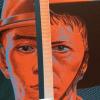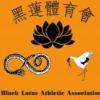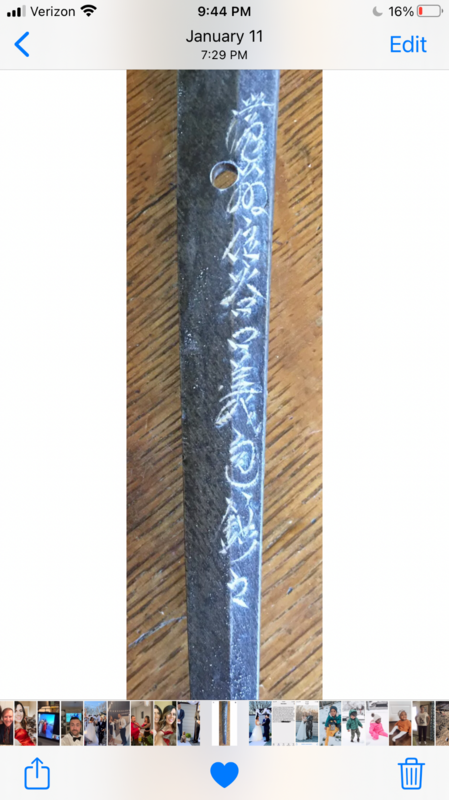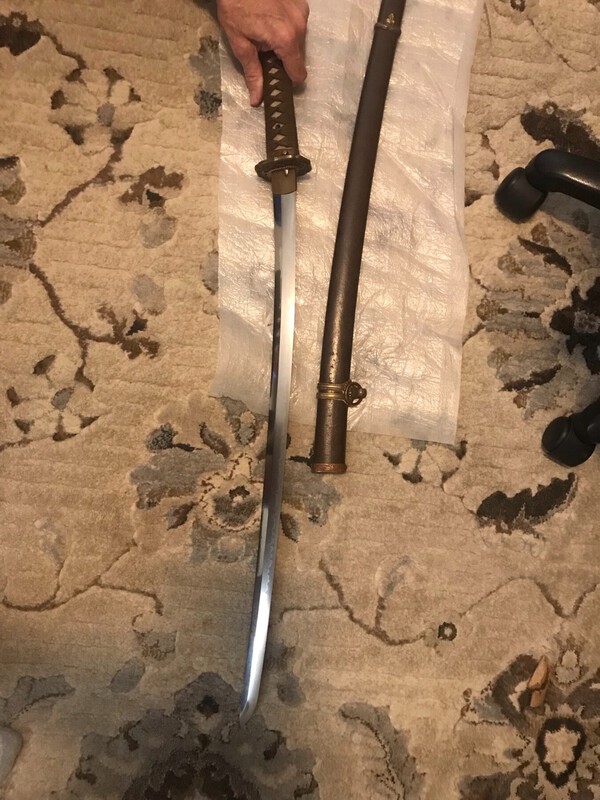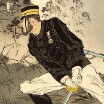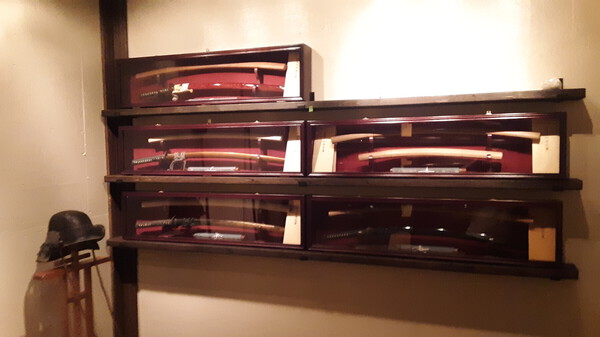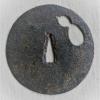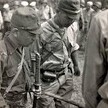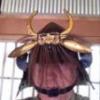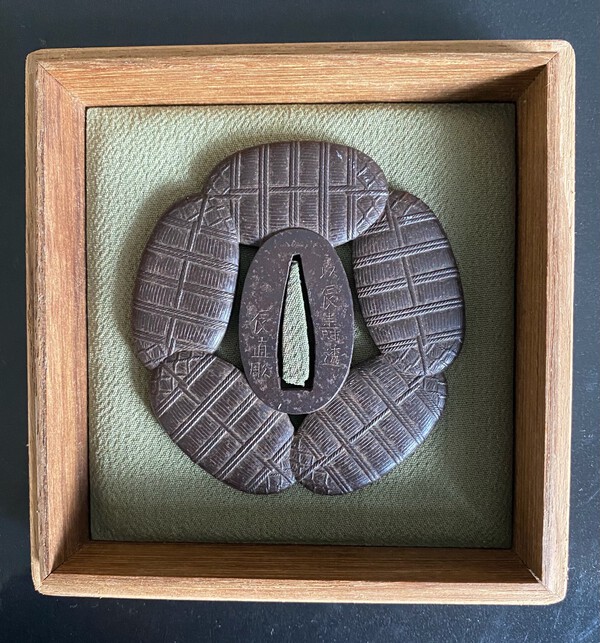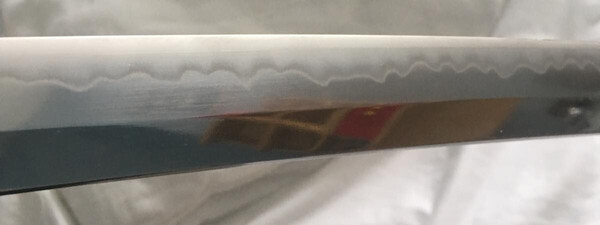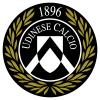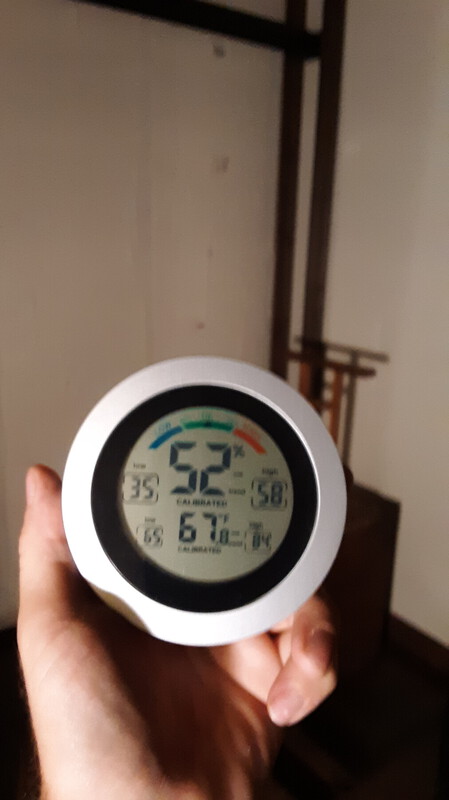Leaderboard
Popular Content
Showing content with the highest reputation on 09/27/2021 in all areas
-
Hi everyone i wanted to start a new thread about this sword I had post d previously Of this sword It had scuffs scratches and a Nick! It is listed 5th seat at the sixth exhibit held in 1941 Because I have been told a sword should be judged by its own merit I thought it was good enough to get be polished by Woody Hall He said it was quite a nice sword so I told to him to have it polished !! I’m glad I did now! I know I won’t get what I put into it but I believed it to be a nice traditional sword now with a good polish that really brought out the hamon!! Woodys comments below Im happy to get feed back!5 points
-
4 points
-
All, I was going to wait until everything was formalized, but I thought I would drop the news here anyway. My wife and I are in the initial phases of opening up the Samurai Museum of Lynchburg, VA. The exhibits will feature arms, armor, and other items from the kamakura through the meiji periods. The targeted space is 1800 sqft. If the venture is successful, we will look to expand. I hope you can all stop by at some point! On a side note, I have been watching the sale section closely for lower priced items to round out certain eras and themes. If you have any suggestions please PM me. Finally, I always appreciate and welcome your thoughts, comments and concerns. Sincerely, Dr. James B. McNicholas III3 points
-
The problem with getting too deep into Mon is they were nearly all open to use by anybody from the Meiji period onwards, including this 3-5-3 Kiri Mon. Sometimes there needs to be examination of the whole sword to determine if there is any special significance to be gained from the Mon. It is an enjoyable little exercise but all too easy easy to get carried away, I know I have on many occasions.3 points
-
Ken, Thank you for the suggestions! We are going to use custom built climate controlled cases similar to what you what find at the NBTHK in Tokyo. Space is our enemy right now. With the sqft we will be working with we have to be very selective. For the soft open we will likely display around 30 swords, 5-10 armor, 5-10 yari & naginata, and many other items. The rooms will be broken down by era, but I may need the help of the board to ensure the groupings are proper. I am sorry you had those issues with your university. This is a self funded project for now, but we have interest from other parties for support. We will see what flushes out. I believe my university may back it if I can built out a large enough section to cover the rise of Christianity in Japan. On that note, it has been very difficult to locate reasonably priced (crypto-Christian) items that touch on this subject. In any event, I'm really glad I have people such as yourself, and other members of the board, willing to share their thoughts and experiences. It will help tremendously.3 points
-
Dear Bob, Item 125 shows Karako Asobi (Chinese Children at Play) which came from the ancient tradition of Chinese art of depicting children playing at four pursuits (painting, chess, harp & calligraphy). This is called kinki shoga in Japanese and was adopted into Japan around the 1400's and became popular in many different types of Japanese art - netsuke, woodblock prints, painting and tosogu. Here's your Kashira with a popular woodblock print (from the 1700's) - you can see that the composition is identical (hat, hair pulling, grabbing the wrist, etc.). As you said, the fuchi has the aftermath with two of the children chasing the other whose chonmage (topknot) has been pulled loose.3 points
-
3 points
-
I would think it is this one by Sukemitsu: https://data.fitzmuseum.cam.ac.uk/id/object/163213 The description of the koshirae matches and as Michael and Kirill said above it seems to be Muromachi Bizen.2 points
-
So Bruce, following all the work you, Thomas, Trystan and Ohmura have done on Mantetsu, can we now assume the following .... !. Blades were manufactured by the Manchurian Railway Company, from their own puddled steel. 2. Some blades were finished at the Nanman factory in China. 3. The mune stamps were, for a better word, tracking numbers or production numbers, stamped in one or other factory in China. And the mei look all cut to a set style . 4. Finished blades were shipped to Japan for mounting, distribution and sale. This appears confirmed from orders and delivery information and documents. 5. There is NO evidence of any Mantetsu/Koa Isshin blades being made in Japan. 6. We know that during the war, blades were in short supply, and the Mantetsu/Koa Isshin solution was an "outsourcing" exercise. So the "light bulb" over the head moment for me was the realization that ALL the blades are made in China, and none in Japan! It would not surprise me either if puddled steel from the Manchurian Electric Furnace was sent to Japanese sword smiths as a substitute for the limited supply of traditional tamahagane. I have examples of Mantetsu swords with Chinese Manchurian Railway Company stamps, as well as Nanman and Dairen stamps from 1938-1944. So without being too controversial, there are actually blades that are papered MADE IN CHINA. All this being said, the Mantetsu blades were highly praised and sought after by the Japanese Officers. I would be interested in comments on the above.2 points
-
Reid How many Japanese swords are there in this museum? Perhaps we can go and visit them as To-Ken Society of GB and talk to them and evaluate the collection. We are, for example, having a members' meeting at the Ashmolean Museum in Oxford in mid-October to view some of the Church collection of tsuba and swords that the Ashmolean holds. On to this sword, it looks like an interesting Bizen blade in high-quality mounts and merits a closer inspection.2 points
-
2 points
-
Things are still coming together. My wife was getting angry with me having everything randomly around the house, so I placed everything in the room. Here are the things I still have to do: 1. Build armor stand. 2. Assemble armor. 3. Clean sword cases and prep blades for display. Am I forgetting anything? Here are some pics to keep things interesting (again sorry about the quality): And all 10 volumes of Dr. K's book for good measure.2 points
-
11. I propped a few cases up on the left wall to examine the lighting. I noticed a few things and am now debating moving the lights back for a wider field. For one, the lights are only hitting the bottom portion of the stands. I could of course just place the koshirae on top with the blades on the bottom, but the bottom most blade would not be in optimal lighting. Again, please ignore the quality of the photos at this stage. Either way, here is a preview. Would love to hear your thoughts!2 points
-
Thank you all for the outpouring of support! I will keep everyone in the loop as we get closer. Per some suggestions, we will be creating video content to document the journey. More to come on that!1 point
-
Like it.. https://www.the-saleroom.com/en-gb/auction-catalogues/lyon-and-turnbull/catalogue-id-srly10342/lot-2c9c9b7a-d448-4a57-acba-ad9f00d3c042 BEST1 point
-
1 point
-
Apparently, Obi-tori refers to the actual hanger ring(s) attached to the Ashi/Haikan - a component of the Ashi/Haikan. Thus, the officer's belt clip would attach itself to the Ashi/Haikan by way of the Obi-tori (ring).1 point
-
At a Netsuké meeting some years ago, a good lady at the Fitzwilliam in Cambridge showed me in passing several drawers of tsuba. “We do not know anything about them,” she explained. I expect they would be happy to get some feedback, if and when an expedition can be organized. (If they haven’t already…)1 point
-
Quick research..https://data.fitzmuseum.cam.ac.uk/search/results?query=Japanese+swords+and+koshirae&operator=AND&sort=desc Bishu Osafune (No) Ju Sukesada Awataguchi Omi (No) Kami Tadatsuna BEST1 point
-
1 point
-
No problem! Its baffling to me too! Insane case of "either I am really blind" or "a fool and his money."1 point
-
1 point
-
Already was posted earlier in the week by yours truly! And our reaction was pretty much the same!1 point
-
Dear Mr. Morita , Thank you for your opinion it is greatly appreciated by me . Would an English translation be along the lines of " This was given at the wish of Lord Yoshisato ( or Lord Yoshitada )" ? or "Gift of Lord Yoshitada" . Your contributions to the board are invaluable and it would be a much poorer place without you. Ian Brooks1 point
-
1 point
-
G'day Guys, A particular style of habaki is associated with the Gassan smiths. There are several variations of this style, but it consists of roundish bare patches within a cat-scratch background. The bare patches are arranged in lines. These habaki can be found in silver foil, gold foil, solid silver, silver gilt and possibly solid gold. I have been doing some research into the origins and symbolism of this design, but haven't got very far. The design seems to have originated with Gassan Sadakatsu. Gassan Sadakazu's blades aren't found with this style of habaki, except perhaps towards the end of his life when Sadakatsu was thought to have been making his blades. Here are some shots of my silver gilt example from 1940. Can anybody shed any more light on this subject? Cheers, Bryce1 point
-
Reid, thank you for sharing! It is a common knowledge that many museums do not have knowledgeable employees when it comes to Japan and its culture. I think your impression is correct that this could be a nice sword with an older blade and high-end KODOGU. Talk to the museum staff or take an expert (preferably from the NMB) there to advise them.1 point
-
This is a very valuable thread for WWII collectors!1 point
-
1 point
-
1 point
-
3-5-3 Paulownia crest (in circle) is fairly common. I wouldn't read too much into it. 5-7-5 is the seal of the Government of Japan. But some ministries use 3-5-3 Paulownia (Ministry of Justice, for example). https://en.wikipedia.org/wiki/Government_Seal_of_Japan But these uses aren't exclusive. It's not quite like the imperial family's use of the 16-petalled chrysanthemum.1 point
-
1 point
-
Removing the tsuka (and tsuba) of a Type 95 versus removing the tsuka (and tsuba) from other types of gunto (97's, 98's, and RS/Type 3's) is not the same. The general rule is to not remove the tsukas from Type 95's (as you have stated, as well as many others here, including Bruce) because 1. Nothing to see of any value on the nakago, and 2. May cause the tsuka to loosen and to not fit as snugly. Regarding the other types of gunto, don't be afraid to remove tsukas as needed. The nakago may provide important information as to the age of the blade, the swordsmith, the date in which the sword was made, etc. And, you may need to remove the tsuka to add seppas, replace other fittings, facilitate repair work/restoration projects, etc. And, as to what the crazy Monkey does with his swords, that's anyone's guess. He attacks just about any edged weapon he gets his hands on.1 point
-
1 point
-
1 point
-
I don't know any serious collector that would recommend taking off the Tsuba on a type 95. There is noting of value to see there and the tsuba may not go back on right and you'll end up with a loose handle. That shows how little that monkey dude knows. BTW, is this a concern for officers swords as well as well? Rgds, Corry1 point
-
Don't quote me, but I believe Obi-tori as the leather loops from belts used on tachi mounts. Don't believe it has anything to do with the suspension ring. Either way, I use the term Ashi because it's the first thing that comes to mind. If you don't feel confident, just call them suspension rings. Nobody here will judge you.1 point
-
1 point
-
1 point
-
1 point
-
Hello Steve. I hope you don’t mind me saying that you are over-thinking this. It is actually pretty straight forward if you step back and look at the situation. Your swordsmith Yoshikane was one of a large number of swordsmiths producing swords for military officers during the war. Officers were required to have swords, but the swords had to be paid for by the officers themselves; they were not issued by the government. For your average, low wage junior officer it was a large expense to purchase this required but generally useless object. There were numerous forges in Japan producing these swords, most of them in Seki. The swords were produced in varying degrees of quality, as were their mounts. Depending on what you could afford you could get a very basic one to meet your uniform requirements, or a better constructed one for more money. Either one would have passed government inspection. To produce large numbers of swords, the steel used and the production methods used would be “modern.” These are the Showa-to. Now, if you wanted a more traditional blade, and you had the money to pay for it, you could have a trained swordsmith use Tamahagane steel, which is the traditional steel used to make ancient Japanese swords. This steel was of course expensive to produce, both in time and resources, and therefor difficult to obtain during a war time situation. The tamahagane that was provided by the government was only given to suitably qualified swordsmiths to use; not your low end assembly line metal pounder. So if you requested a traditionally made sword, a suitably skilled swordsmith would use the good material, and take the time needed to make what we these days would call a Gendai-to. When that particular smith was not being paid to invest a lot of time on a more quality piece, then he would be banging out the mass produced stuff like everyone else because that was his job, and he probably had a quota to meet for production volume. The description you included with your photos says the swordsmith had a sword judged as 5th seat. This 5th seat does not mean he came in 5th in the competition. It means the competition split the entrants into 5 categories of workmanship. Fifth seat rating means good enough to have your name put on the list as a professional level swordsmith. It was not a participation trophy in that there were participants that did not make the cut. That is all it really means. It is highly unlikely the sword in your possession is the sword submitted for the competition, and your seller made no such claim that it was. As far as whether the sword is one of the smith’s Showa-to or one of his Gendai-to, that would require evaluation of the sword itself. If the sword does not have a Showa stamp or a Seki stamp, then it is not automatically lumped into the Showa-to category, so that is a good thing. You need to physically put that sword into the hands of someone with experience to have him or her look at it. You can only do so much with photographs. Enjoy your sword, and do not fret about it too much. Show it to someone with experience for their evaluation. If you keep showing photos to masses of people with differing levels of experience on an internet forum you are going to get a wide variety of opinions and you don’t get to pick which one is correct. Bob Gilmore1 point
-
Looks fantastic! What does the door look like? It would be great if it were built of absurdly heavy timbers, with a thick bolt you could drop into place from the inside, like on a fortress door. Then it could double as a safe room—by the time any intruders battered their way in, you’d be kitted up in yoroi and ready for battle... *Edit* I see you’ve got a modern door with locks—well, I suppose you could go the practical route🤣0 points
This leaderboard is set to Johannesburg/GMT+02:00


